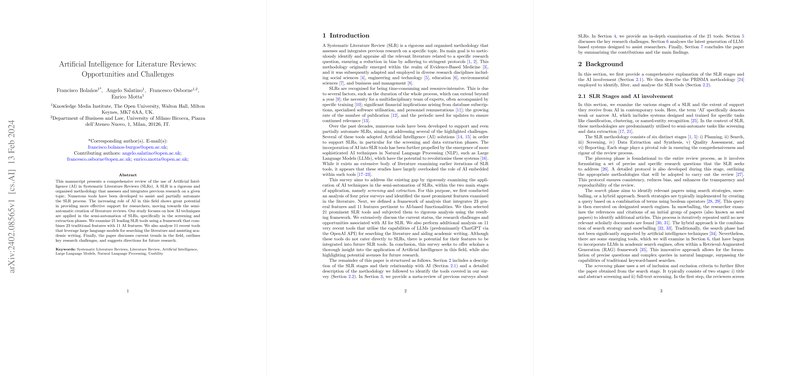Exploring the Role of Artificial Intelligence in Streamlining Systematic Literature Reviews
Introduction
Systematic Literature Reviews (SLRs) serve as a cornerstone in the empirical foundation across various disciplines, meticulously synthesizing existing evidence on a given topic to guide research and policy. Despite their importance, the process of conducting SLRs is notoriously resource-intensive, involving extensive manual labor that can span several months or even years. This survey presents a comprehensive examination of the role AI plays in semi-automating the SLR process, particularly focusing on the screening and extraction phases. By analyzing 21 leading SLR tools and discussing recent advancements incorporating LLMs, this paper offers insights into both the current capabilities and future directions of AI in this domain.
AI in the SLR Process
Screening Phase
The application of AI in SLR tools predominantly addresses the screening phase, aiming to reduce the laborious task of manually sifting through vast amounts of literature. Our analysis reveals a diverse array of methodologies employed across tools, from straightforward classification algorithms to more sophisticated NLP techniques leveraging word and sentence embeddings. However, it's noteworthy that many tools still rely on traditional AI methods, indicating a potential area for further advancement.
Key findings include:
- Diverse research field applicability: The majority of tools are designed to support SLRs across a wide range of disciplines, though some specialize in biomedicine.
- Varied AI tasks: Beyond mere classification of papers, some tools offer advanced functionalities, like identifying Randomized Controlled Trials (RCTs) or enabling clustering of studies based on thematic similarities.
- Minimum requirement for training: Tools differ significantly in the number of papers required to effectively train their classification models, influencing their practical usability.
Extraction Phase
Though less common than in the screening phase, AI's influence on the data extraction phase is growing. Four notable tools incorporate AI to automate aspects of data extraction, ranging from Named Entity Recognition to linking extracted entities within or across documents. This application of AI demonstrates potential for streamlining one of the most time-consuming stages of the SLR process, yet it also underscores the need for further refinement and validation of these techniques.
The Emergence of LLMs
The advent of LLMs, such as those developed by OpenAI, presents exciting opportunities for revolutionizing the SLR process. Preliminary tools leveraging LLMs offer functionalities like natural language-based search queries and AI-assisted writing of literature reviews. While these tools are in early stages, they embody the potential for significantly reducing the manual effort required in conducting SLRs and enhancing the accessibility of up-to-date scientific knowledge.
Challenges and Future Directions
Despite the promising applications of AI in SLRs, several challenges persist:
- Adoption barriers: Usability issues and steep learning curves deter widespread adoption of existing AI-enabled SLR tools.
- Ethical considerations: Ensuring the ethical use of AI in scientific literature synthesis necessitates ongoing vigilance.
- Quality assurance: As AI tools become more autonomous, mechanisms for maintaining the accuracy and reliability of their outputs are paramount.
The survey advocates for the continued evolution of AI technologies in SLR tools, emphasizing the importance of blending AI's computational efficiency with human oversight to ensure the integrity of systematic reviews.
Conclusion
The integration of Artificial Intelligence into the SLR process signifies a transformative shift towards more efficient research synthesis methodologies. By automating labor-intensive tasks and harnessing the power of LLMs, AI-driven tools hold the promise of enhancing the quality, speed, and accessibility of systematic reviews. Continued innovation, coupled with a focus on usability and ethical considerations, will be crucial in realizing the full potential of AI in this pivotal arena of academic research.
